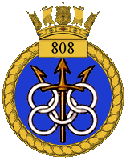 |
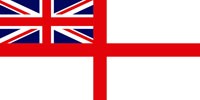 |
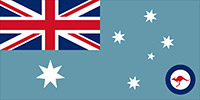 |
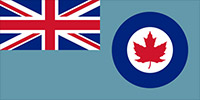 |
 |
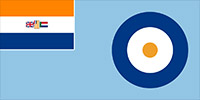 |
History of 808 Squadron
808 Squadron was formed at RNAS Worthy Down in July 1940, flying 12 Fairey Fulmars in the role of a Fleet Fighter squadron. They were initially assigned to the Isle of Man to carry out patrols over the Irish Sea, but were soon transferred to Wick for the defence of the dockyards. They were then reorganised to serve with RAF Fighter Command, becoming one of only two Fleet Air Arm squadrons to take part in the Battle of Britain, the other being 804 Naval Air Squadron. By October they had received their first carrier assignment and joined HMS Ark Royal with Force H in the Mediterranean. The squadron shot down two enemy aircraft in an attack on Sardinia in November, followed by another two in operations over Sicily in January 1941. They then shot down another while defending Malta in May.
The squadron sailed with Ark Royal into the Atlantic later in May to hunt the German battleship Bismarck. They then returned to the Mediterranean after the sinking of the Bismarck, and in July and August claimed 15 aircraft shot down with 807 Naval Air Squadron. They were still aboard Ark Royal when she was torpedoed and sunk by Friedrich Guggenberger's U-81 in November, with the loss of many of the squadron's aircraft. The remaining aircraft were landed at Gibraltar, and were then merged into 807 Squadron.
808 Squadron was re-formed with six Fulmar IIs aboard HMS Biter in January 1942. They came aboard HMS Battler between April and May 1943, and took part in operations covering the Salerno landings in September 1943. They then formed part of the 3rd Naval Fighter Wing, returning to the UK aboard HMS Hunter. They were re-equipped in May 1944 at RNAS Lee-on-Solent with 20 Supermarine Seafire L.IIIs and attached to No. 345 Reconnaissance Wing of the 2nd Tactical Air Force, Royal Air Force. They covered the Normandy Landings, and were then re-equipped with 24 Hellcat Is and IIs. They embarked aboard HMS Khedive in January 1945 and sailed to join the Eastern Fleet.
Here 808 Squadron operated off Malaya and Sumatra, with periods spent flying off HMS Emperor. They covered the re-occupation of Rangoon in May, carried out strikes against Japanese airfields in Sumatra in June, and covered the re-occupation of Malaya after the Japanese surrender. The squadron was decommissioned at the end of the war.
Battle Honors:
Spartivento 1940, 'Bismarck' 1941, Malta Convoys 1941, Atlantic 1943, Salerno 1943, Normandy 1944, Burma 1945
Commanding Officers and Squadron Personnel
Lt HER Torin, RN July 1940-July 1940
L/C RC Tillard, RN July 1940-May 1941
L/C EDG Lewin, RN May 1941-Nov 1941
Lt CP Campbell-Horsfall, RN Jan 1942-March 1943
L/C(A) AC Wallace, RNVR March 1943-Oct 1943
L/C(A) JF Rankin, DSC, RN Oct 1943-May 1945
L/C(A) CF Wheatley, RNVR May 1945 -June 1945
L/C(A) RF Bryant, RN June 1945 - end of WW2Aircraft
Fulmar I July 1940-1941
Fulmar II 1941-Nov1942
Spitfire Vb hooked Dec 1942-April 1943
Seafire L.IIc Dec 1942 -May 1944
SpitfirePR.XIII March 1944 -March 1944
Spitfire Vb Feb1944 -May 1944
Spitfire LF.Vb May 1944-July 1944
SeafireL.III June 1944 -Oct 1944
Hellcat I Oct 1944-March 1945
Hellcat II Oct 1944-end of WW2The USS Cordova (CVE-39) (originally AVG-39 then later ACV-39) was an escort aircraft carrier launched 27 December 1942 by Seattle-Tacoma Shipbuilding of Tacoma, Washington; sponsored by Mrs. A. E. Mitchell. Reclassified CVE-39 on 15 July 1943, Cordova was transferred to the Royal Navy on 25 August 1943, as HMS Khedive (D62). She was returned to United States custody on 26 January 1946 and sold into merchant service 23 January 1947 as Rempang (later Daphne). She was sold for scrap in Spain in 1975.
USS Cordova (CVE-39) HMS Khedive 01
Photo 01: USS Cordova (CVE-39) HMS Khedive during Sea trials
USS Cordova (CVE-39) HMS Khedive 02
Photo 02: HMS Khedive just inside the breakwater entrance of the Grand Harbour in Malta. In the background of this photo lies Fort St. Michael (although somewhat obscured by the carrier's emission) whilst the breakwater arm on this side of Fort St. Michael is quite recognisable. This picture was possibly taken in late 1945. (Thanks to Noel Paris, who provided additional info).
CVE-39 CORDOVA
Displacement: 16,620 t. (full load)
Length: 495'8”
Beam: 69'6”
Extreme Width: 111'6”
Draft: 26'
Speed: 18 k.
Armament: 2 5”Class: PRINCE WILLIAM
CORDOVA (ACV-39) was launched 27 December 1942 by Seattle-Tacoma Shipbuilding Corp., Tacoma, Wash.; sponsored by Mrs. A. E. Mitchell. Reclassified CVE-39 on 15 July 1943, CORDOVA was transferred to the Royal Navy on 25 August 1943, as HMS KHEDIVE. She was returned to United States custody on 26 January 1946 and sold on 23 January 1947 without having had any active service in the U. S. Navy.
Source: Dictionary of American Naval Fighting Ships, (1963) Vol. 2, p.186.

 Editor for Asisbiz: Matthew Laird Acred
Editor for Asisbiz: Matthew Laird Acred
If you love our website please add a like on facebook
Please donate so we can make this site even better !!
